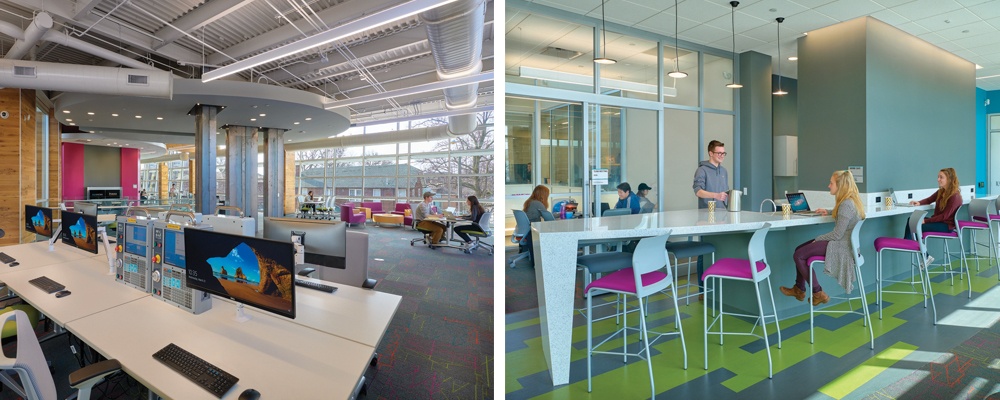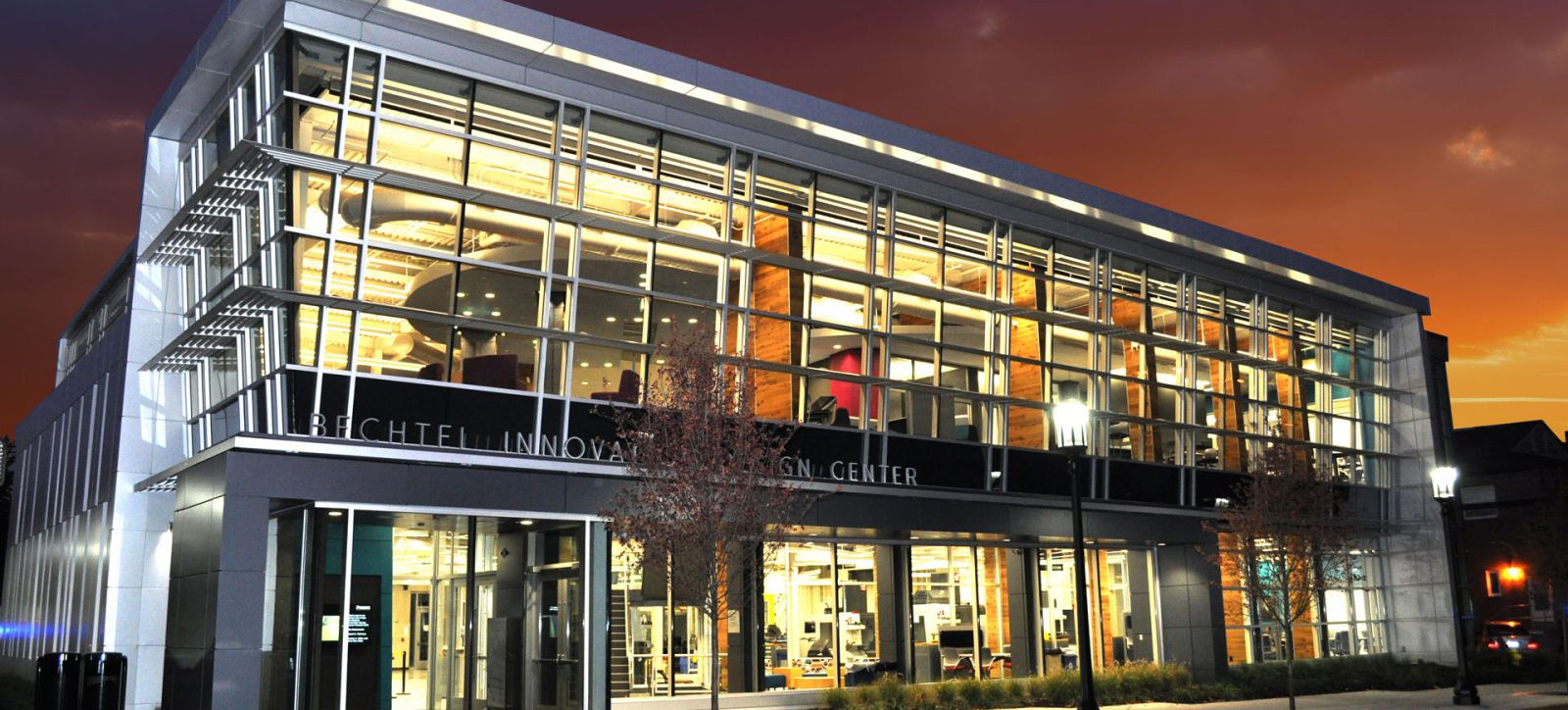They sure don’t make them like they used to anymore! This age-old saying rings true for cutting-edge higher educational facilities that are being built at colleges and universities across the U.S. At Purdue University, students, faculty, and staff have settled into the College of Engineering and Purdue Polytechnic Institute's sparkling Bechtel Innovation Design Center, which opened in September 2017. In just a few semesters since its ribbon-cutting ceremony, the BIDC is proving why collaborative learning spaces increase educational innovation and student engagement while offering numerous advantages from a facilities and operations lens.
With a total price tag of $18.5 million (coming in slightly under budget) and delivered on time in just 15 months, Purdue has a new learning center to be proud of.
We talked with the university’s Chief Operations Officer, Jay Wasson, the BIDC’s Director, Dr. Matthew Swabey, and PMs Deborah Johnson and Tom Marshall to explore the building’s inception, planning, and construction and the day-to-day operational impact it is having on Purdue’s campus.
What was the driving force behind the BIDC?
Dr. Matthew Swabey: The Bechtel IDC is an outgrowth of the need for student project space on campus. The College of Engineering had been receiving requests for student space for several years, and it was brought to a head when the Purdue Engineering Student Council gave a substantial donation to underscore the need. From the beginning, it was understood there was no available space on campus that could accommodate this project. The College of Technology (now known as Purdue Polytechnic Institute) was experiencing the same demand, and the two Deans collaborated to make requests for donations and equipment.
How about input, what kind of campus/community outreach was performed in advance?
Swabey: Several campus-wide forums for faculty, staff, and students were held to help us understand design needs. We discovered tremendous support from and by the campus community.
How was the collaboration between all stakeholders?
Jay Wasson: Part of the success of this facility can be traced back to the collaborative nature of its design and construction. The university’s project management, architecture, and operations functions are all within my organization. This makes it easy for the groups to interact on a daily basis to ensure projects are moving forward effectively. We also have regular meetings with our project clients and with our AEs and contractors to make sure everything is running smoothly. Our project managers also spend a lot of time on-site to help address items that come up in the field.
Throughout the planning process, our group worked to ensure that the [BIDC] not only met the needs of the colleges but also stayed within budget and aesthetically and functionally fit its location along our Student Success Corridor.
Deb Johnson/Tom Marshall: It was the College of Engineering, Polytechnic Institute, and then we had multiple departments within our organization, which comprised of fire and safety, shops, engineering, reviewers, utilities, telecom, and IT. There was a desire for the building to appear contemporary and include elements of glass but at the same time, we wanted to fit within the surrounding landscape — a traditional campus. There were some differing opinions on that, which did pose some challenges in the design phase.

Were there any challenges posed as a result of the project’s construction
Wasson: We always knew we wanted the BIDC to be located on an active pedestrian thoroughfare in or close to the heart of campus. During construction, however, this can make things more challenging. Its location meant we had a smaller laydown area and had to have a strong pedestrian and vehicular maintenance of traffic plans to safeguard the campus community traveling through the area.
What were the immediate impacts after the BIDC opened its doors?
Wasson: Upon opening, the BIDC quickly became a popular destination. The reasons for this were threefold: its location, design, and purpose. The facility is located in an area with heavy student foot traffic, its glass front helps break down potential barriers to entry, and it is meeting a previously-existing need for more student project space.
With the facility now one year old, have you managed to make optimum use of it?
Wasson: By designing the space to be flexible, it allows us to adapt the facility to the changing needs of the colleges. This has helped ensure that space is optimally usable, which is something we consider vital in new construction. We’re charged with being good stewards of the university’s finances, and if we’re building new space, we want to make sure there’s a good plan in place for how it’s going to be used over time.
 |
| Image courtesy of Purdue University |
Have you been able to re-purpose other classroom space as a result of the new facility?
Wasson: The BIDC primarily helped address an existing need for project space in the College of Engineering and the Purdue Polytechnic Institute. Both of these colleges have growing enrollment, but the facility isn’t limited to students in those majors; it’s open to everyone.
Swabey: There has [also] been an opportunity to re-purpose space within the Armstrong Hall of Engineering resulting from the movement of equipment out of the Artisan and Fabrication Lab into the BIDC.
What lesson(s) would you provide to other facilities leaders seeking to open a similar building on their respective campuses?
Wasson: Having a space dedicated to collaborative student work really emphasizes to the students that the University administration prioritizes that type of interaction. Working in teams and leading your own projects are key skills we know will serve our students well after they leave the university. Collaboration in the design phase for a building like this is key. We had to understand the many ways the colleges envisioned using the space in order to meet their needs.
Swabey: The students benefited enormously in the first year of the Bechtel IDC’s operation. Since opening, a total of 1942 students have signed up. These students logged 41,560 team impact hours over 1079 projects. Notable teams reaching podium finishes were Purdue Electric Racing and the AMET Rube Goldberg team. The student-built SEDS methane-liquid oxygen rocket will attempt an orbital launch in 2019. Multiple staff have used the Bechtel IDC to pioneer novel classes, including one building replicas of DaVinci’s inventions and another where the student team demonstrated their project in NASA’s neutral buoyancy laboratory.
What is one physical feature of the center that you find particularly innovative?
Wasson: I think the most important feature of the facility is the flexibility... Equipment can be changed and HVAC settings adjusted — all to meet the needs of whatever team or project may be coming in next. This is what makes this facility such a good home for innovation now and in the future.
Swabey: The cutting-edge features of the Bechtel IDC is the amazing flexibility of its infrastructure. The equipment fit has been constantly updated, the latest capital investment is a set of metal 3D printers based on polymer-jetting technology. Power and air exhaust are easily available with minimal changes if at all. The flexibility of the bus bar system used in the main manufacturing lab has enabled multiple equipment configuration changes responding to operational needs inside the facility. The state-of-the-art computer-controlled locks substantially reduce the training load users have to bear and simplify managing the safety of the student users.
How about energy consumption?
Wasson: The building was designed to [meet] LEED silver standards; however, we have not sought certification yet.
The building looks very student-centric, almost in a self-serving capacity. Elaborate on this point: do you see the future of innovation centers as spaces that can fully empower students to take hands-on learning to the next level?
Wasson: The university’s strategic direction, known as Purdue Moves, highlights “transformative education” as one of five key pillars for success. The Bechtel Innovation Design Center strongly ties to that goal and almost acts as a physical embodiment of what transformative education can look like. This facility and the activities that take place inside it will help prepare our students for real-world careers.
As Purdue University enters its second academic year with an up-and-running BIDC, the center will continue to provide endless opportunities for its students to collaborate on new ideas in a space with advanced technology that may have once seemed too futuristic or far-fetched. The welcoming reality is that these types of buildings are game-changers for leading colleges and universities, and the Bechtel Innovation Design Center is a model facility for this evolution of student learning space for modern higher education.

Posted by
Join us at HEFF!
An interactive retreat for facilities leaders at the nation's top colleges and universities.
Nov 8-10, 2026 | San Antonio, TX
Learn More









Comments